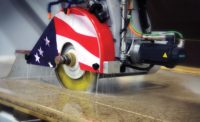Water. Abrasive. Sludge. Stone fragments. All standard findings in a countertop fabrication shop. What impact can these harsh elements have on your business? Machine downtime.
Machine downtime can be very “painful” and very costly – especially if it was unplanned. It is estimated that the average cost for unplanned downtime is approximately $1,500 per hour. Shop inefficiencies, employee overtime, missed shipment dates and schedule shuffling all contribute to this cost of unplanned downtime.
These pains and excessive costs can be avoided by implementing a maintenance mindset culture within your operations. Everyone would agree that unplanned downtime is painful and costly, but yet a large majority of shops do not perform regular maintenance on their machines.
Understanding the value
“Establishing a maintenance-focused culture is the first step in maximizing machine uptime,” said Nate Lommel, Park Industries customer service manager. “Owners and operators need to understand the business value of planned maintenance and be 100% committed and recognize the positive, financial impact such a program has on their bottom-line profitability.” A maintenance-focused company performs routine maintenance tasks regularly, which minimizes unplanned downtime, ensures higher-quality production, forces organization within and reduces business delays – all positively impacting the bottom-line profitability.
Designated employee
Once a maintenance mindset culture is embraced, the next step is to assess your employee skill sets. Is there an operator who has the ability to regularly maintain the machine, given the proper tools and training? Should you hire a full-time employee who is solely focused on maintenance? “If you do the math on the cost of unplanned downtime at $1,500 per hour, you could hire a part-time maintenance person for $26,000 to avoid just 16 hours of downtime a year,” explained Lommel. “The ROI on hiring a part-time, if not full-time, maintenance person is well worth the investment and will have a positive impact on your bottom-line profitability.”
Selecting the right person to manage your maintenance program is very important. Under-skilled or poorly matched people working in maintenance can result in sizable operational risk, as opposed to being a productive asset to your company.
Training. Training. Training.
You have embraced the value of maintenance, have selected a person who will be responsible to regularly maintain your machine, now it is time to train the employee on how to successfully maintain your machines. Take the approach of creating a culture of strategic training instead of reactive or just-in-time training because your machine is down.
Typically, machine manufacturers will offer or provide maintenance manuals, as well as pop-up alarms on your machine that will alert you of standard maintenance procedures. In addition, there may be advanced maintenance clinics that you may consider exploring, increasing the knowledge and skills of the maintenance technician. Both hands-on training and classroom training are valuable.
Create a work environment of a procedure-based maintenance program, with the help of the machine manufacturer, to eliminate the guesswork out of the many maintenance tasks that must be routinely performed.
If you experience prolonged downtime, even with a dedicated maintenance person, it is an indication that you may not have the right person in the role, they need additional tools and training to be successful or your maintenance culture has not taken root within your organization. Prolonged downtime may also require you to reach out to your machine manufacturer for assistance.
Maintain critical parts
Having critical and consumable parts in inventory will dramatically reduce unplanned downtime costs. A simple, yet very common example, is diamond orifice consumption. The orifice on a sawjet system is considered a consumable part. Below is the costly example of not having an extra orifice in your inventory, ready on the shelf to be installed as soon as it needs to be replaced.
“You will be amazed at the true costs of not having critical or consumable parts on your shelf,” said Lommel. Work directly with your machine manufacturer who will help identify critical components or consumable parts to purchase for your equipment to avoid costly downtime.
Planning and scheduling maintenance
To be successful, machine maintenance needs rhythm with no schedule changes or few surprises. With proper planning and scheduling, preventive maintenance will alert you early that certain components are wearing and need to be replaced. It’s hard to plan and schedule corrective action if you cannot proactively see the need. Performing regularly scheduled maintenance on your machines will allow you time to respond to root causes of failure long before the repair is needed. Thoughtfully planned and scheduled maintenance makes unplanned breakdown events a rare exception.
Maintenance culture value
Is your company plagued with chronic unplanned downtime? Establishing and embracing a maintenance-focused culture will eliminate unplanned downtime. Select, nurture and inspire the right people on your team to build a prosperous maintenance culture within your company. The ROI on this culture change will be very valuable for your company. You will see your bottom-line increase, your shop running more efficiently and your machine longevity increase. Invest today in developing a maintenance-focused culture.





